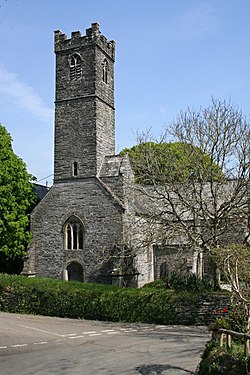Quethiock
| Quethiock | |
| Cornwall | |
|---|---|
 Parish church of St Hugh | |
| Location | |
| Grid reference: | SX313647 |
| Location: | 50°27’29"N, 4°22’41"W |
| Data | |
| Population: | 443 (2011) |
| Post town: | Liskeard |
| Postcode: | PL14 |
| Local Government | |
| Council: | Cornwall |
Quethiock is a delightfully named village in south-eastern Cornwall, roughly five miles east of Liskeard. According to the 2001 census the parish had a population of just 429. The ancient parish church, St Hugh, is one of the most notable in Cornwall.
The name of the village is from the Old Cornish cuidoc meaning wooded place.[1] In 1871 the population was 661 and the area 4,351.0 acres (17.6 km²).
Life of the village
Formerly part of the Pentillie Estate and owned by Squire Coryton, most of the properties passed into owner occupation after a forced sale to meet Estate Duty in the early 1920s.
The village has not had a public house since the closure of the Mason's Arms in the 1920s. There was a post office at Ivydene until the 1960s not long before the closure of the village General Supply Stores which not only sold everything from groceries to petrol and organs but also delivered weekly groceries to farms, mills and cottages throughout a radius of 15 miles. There was a village shop, which closed in the 1980s.
Quethiock's economy is centred principally around nearby Liskeard and Plymouth. The vast majority of the village's population is either retired or in full-time work. It is estimated that 0.29% of the population is employed in the postal sector. There is a local Church of England primary school.
Besides the church and school, three other public services are available in Quethiock: the post box, the phone box and the bus shelter. Internal village matters are communicated by means of the parish noticeboard, located at the centre of the village.
Parish Church of St Hugh
The original church was cruciform in plan but a tower was added (probably in the 13th century) and then the aisle. There are old wagon roofs and a funeral recess (14th century).
The church was restored in the 1880s after becoming virtually ruinous in the 1870s.
The stained glass and some other ornamental work is the handiwork of the late 19th century vicar, William Willimott, and there are three brasses (1471 to Roger Kyngdon, and 1631 to Richard Chiverton, d. 1617, and his wife).[2] Willimott's predecessor as vicar was the Rev Dr John Rooke Fletcher (d. 1878) who was vicar for 61 years.[3] There were Methodist chapels and almshouses (Directory for 1873).
Outside links
| ("Wikimedia Commons" has material about Quethiock) |
References
- ↑ Mills, A. D (1991). The Popular Dictionary of English Place-Names. Parragon Book Service Ltd & Magpie Books. p. 266. ISBN 0-7525-1851-8.
- ↑ Dunkin, E. (1882) Monumental Brasses. London, Spottiswoode
- ↑ Brown, H. Miles (1976) A Century for Cornwall. Truro: Oscar Blackford; p. 29
- French, Mary (1977) A Victorian Village: a record of the parish of Quethiock in Cornwall. Falmouth: Glasney Press ISBN 0-9502825-6-1
